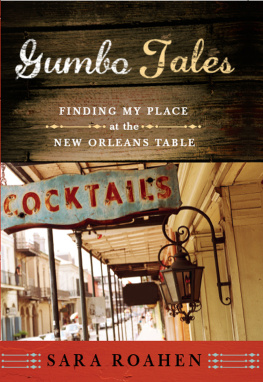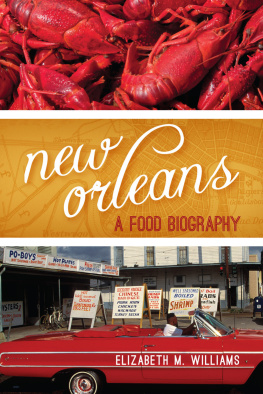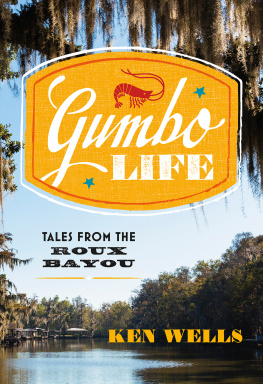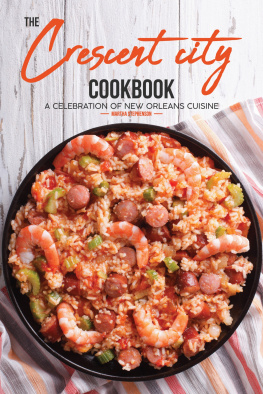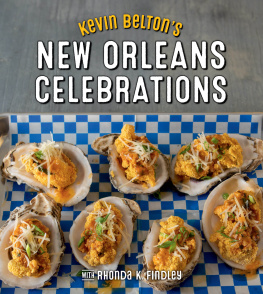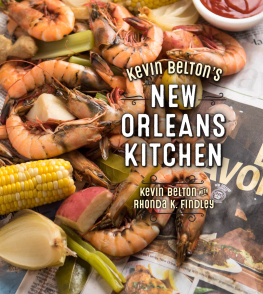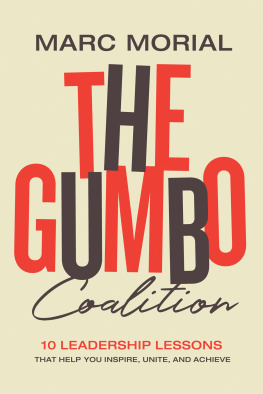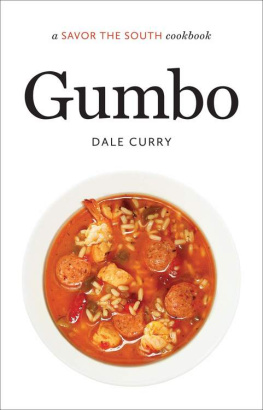GUMBO TALES
Finding My Place at the New Orleans Table
Sara Roahen
W. W. NORTON & COMPANY
NEW YORK LONDON
Copyright 2008 by Sara Roahen
All rights reserved
For information about permission to reproduce selections from this book, write to Permissions, W. W. Norton & Company, Inc., 500 Fifth Avenue, New York, NY 10110
Library of Congress Cataloging-in-Publication Data
Gumbo tales: finding my place at the New Orleans table / Sara Roahen.1st ed.
p. cm.
Includes bibliographical references.
ISBN: 978-0-393-07206-8
1. New Orleans (La.)Folklore. 2. Food habitsLouisianaNew Orleans. 3. Drinking customsLouisianaNew Orleans. 4. New Orleans (La.)Social life and customs. I. Title.
GR110.L5R63 2008
398.209763'35dc22 2007039312
W. W. Norton & Company, Inc.
500 Fifth Avenue, New York, N.Y. 10110
www.wwnorton.com
W. W. Norton & Company Ltd.
Castle House, 75/76 Wells Street, London W1T 3QT
For each of you who fed me,
for each of you who shared my table, and
for the city that brought us together.
Contents
GUMBO
A Higher Education
SAZERACS
I Take My Liquor Brown
SNO-BALLS
The Bittersweet of Summertime
RED GRAVY
Pray for Us
STUFFED, SMOTHERED, ZHERBES
Vegetables, a New Religion
PO-BOYS
Not in California Anymore
TURDUCKEN
Tales of a Poultry Chimera
CRAWFISH
A Crawfish Is a Darned Beast!
POISSON MEUNIRE AMANDINE
The Creole Conundrum, and the Alibi
PHO
If at First You Dont Belong
COCONUTS, KING CAKE, AND YA-KA-MEIN
Taking It to the Street
LE BOEUF GRAS
Food Radio, and an Unwitting Mentor
COFFEE AND CHICORY
In Reverence of Things Past
RED BEANS AND RICE
Rising to the Occasion
OYSTERS
Size Matters
AFTERWORDTURKEY BONE GUMBO
You Can Take It with You
Note
OCTOBER 2005
A flood can disappear neighborhoods, it can cause good-hearted police officers to commit suicide on duty, it can rust ten thousand perfectly seasoned cast-iron skillets, and it can banish a thriving Vietnamese community to refugee status, again. Im going to suspend disbelief for the next sixteen chapters, however, and assume that a flood cannot destroy the most interesting and ingrained food culture in my country.
If my use of the past and present tenses is loose at times, its not because Ive overlooked the inconsistency. In a city where there never was an obvious delineation between the now and the then, disasters of nature and government blur the lines to the brink of invisibility.
GUMBO TALES
GUMBO
A Higher Education
N ot long after I moved to New Orleans, my younger sister, Stephanie, flew down from our home state of Wisconsin to evaluate the city as a prospective home. Exercising New Orleans most persuasive means of seductiondinnerI took her to the great neighborhood restaurant Liuzzas Restaurant & Bar and ordered like mad: Abita Amber beer in frosted schooners, fried green tomatoes with shrimp rmoulade, a stuffed artichoke, fried chicken, seafood gumbo.
Ew, Stephanie said, inhaling, when the gumbo arrived. It smells like Haumersons Pond.
Her judgment hung over the table carpeted in algae, murk, and other scummy aquatic things wed never dreamed of eating as little girls. Haumersons Pond began where our paternal grandparents front yard dropped off. Wed never so much as dipped a toe in it, but the pond had fired our childhood imaginations and filled our free time. Wed poked branches into the thick mud that surrounded its expanse and watched older boys slide hockey pucks across its frozen plane. Wed known absolutely that its depths contained hideous beasts: swamp monsters, alligators, quivering spiders, crayfish.
Stephanie went wan at the scent of Liuzzas gumbo, just like our mom does when she detects anything fishy. Its appearance couldnt have helpedthe gloomy broth splashed up the bowl and ringed it with a chlorophyllous sediment. Without lifting her spoon, Stephanie pushed the soup brimming with shrimp, oysters, and several landlubber components to my side of the table. I passed her the fried chicken.
One of the best lines ever written about food is in Eating Together , the funny, touching book on which two friends with New Orleans ties, Peter Feibleman and Lillian Hellman, collaborated. If youre having a pompous gourmet to dinner, gumbo, I think, is a good main dish, writes Feibleman, whose own humility is questionable at times.
Its true: gumbo is an event. In New Orleansspeak, you have a gumbo, like you have a barbecue or a picnic. I once attended a Fourth of July gumbo in the Seventh Ward; the hostess served us barbecued ribs, candied sweet potatoes, and stuffed fish on disposable plates, but she ladled her gumbo into pretty china bowls. Gumbo can be reason enough foranything, really. Its not unthinkable that a person would decide to pack up a U-Haul and head south based on a single transcendent bowl of it. Stephanie wound up doing just that, but I still should have known to start her off with a seafood-free chicken and sausage gumbo instead.
Though Stephanie was born eighteen months after I was, she arrived with a head of raging purple-orange hair (I was still bald), an insatiable desire to be tickled (my nightmare), and a bright future as a forward on the varsity basketball team (I was asked to resign quietly from the junior varsity team after one season on the bench). In other words, Ive spent most of my life trying to keep up with my younger sister. Finally, as an adult, I discovered food to be the one arena in which she could be out-toughed. After college, while Stephanie trained for marathons and learned to surf, I slugged it out in the testosterone-fueled community of line cooks. She learned to pitch a tent in a hailstorm; I learned to saut and swear like a sweaty boy. She developed a taste for Clif Bars; I tasted everything in the walk-in for signs of spoilage. Now she was in New Orleans shopping Ph.D. programs, and I was pursuing a higher education in gumbo.
There is an elemental, forever landlocked part of me that reacts precisely the way Stephanie did when faced with the more aromatic qualities of seafooda part of me that still fears eating the unknown as much as it fears, say, quivering spiders. Over time, however, Ive learned to channel that anxiety into curiosity and even desire, which must be what enabled New Orleans various gumbosthose of the swamp and those of the prairieto snag me, first by the nose, then by the belly, and soon enough by the heart.
Gumbo is the most important dish in the Louisiana lexicon for its prevalence and dependability alone. Its difficult to come up with a single regional-leaning restaurant in New Orleans with a menu of any substance that doesnt serve some version of it at least once a week. Gumbos pervasiveness does not, however, diminish the dishs mystique; just as its variations are infinite, so are gumbos controversies and questions.
Every native can, and is dying to, describe her quintessential gumbo down to the final grain of rice, rice being the single constant among gumbos. Usually. There are at least as many definitive gumbos in Louisiana as there are accents, and like accents, definitive gumbos are established at home. Its an intensely esoteric topic, as personal as pie crust and pimento cheese: whatever style a person grows up eating tends to remain her ideal for eternity. If you disagree with that ideal, its clearly because youre impaired in some sad, fundamental way.
My first inkling of native gumbo biases came courtesy of my friend Lolis Elie, a writer and skilled interlocutor of his citys food culture. When I once asked his gumbo preference, Lolis directed me to Fays Take-Out (since closed) in Gretna, a town just across the Mississippi River from New Orleans. On Fridays, Fay Antoine served the only retail gumbo that lived up to a standard originally set by Loliss late grandmothera robust and briny seafood potage that was thinner than most New Orleans restaurant gumbos Id tried but thick as a cypress swamp in flavor.

